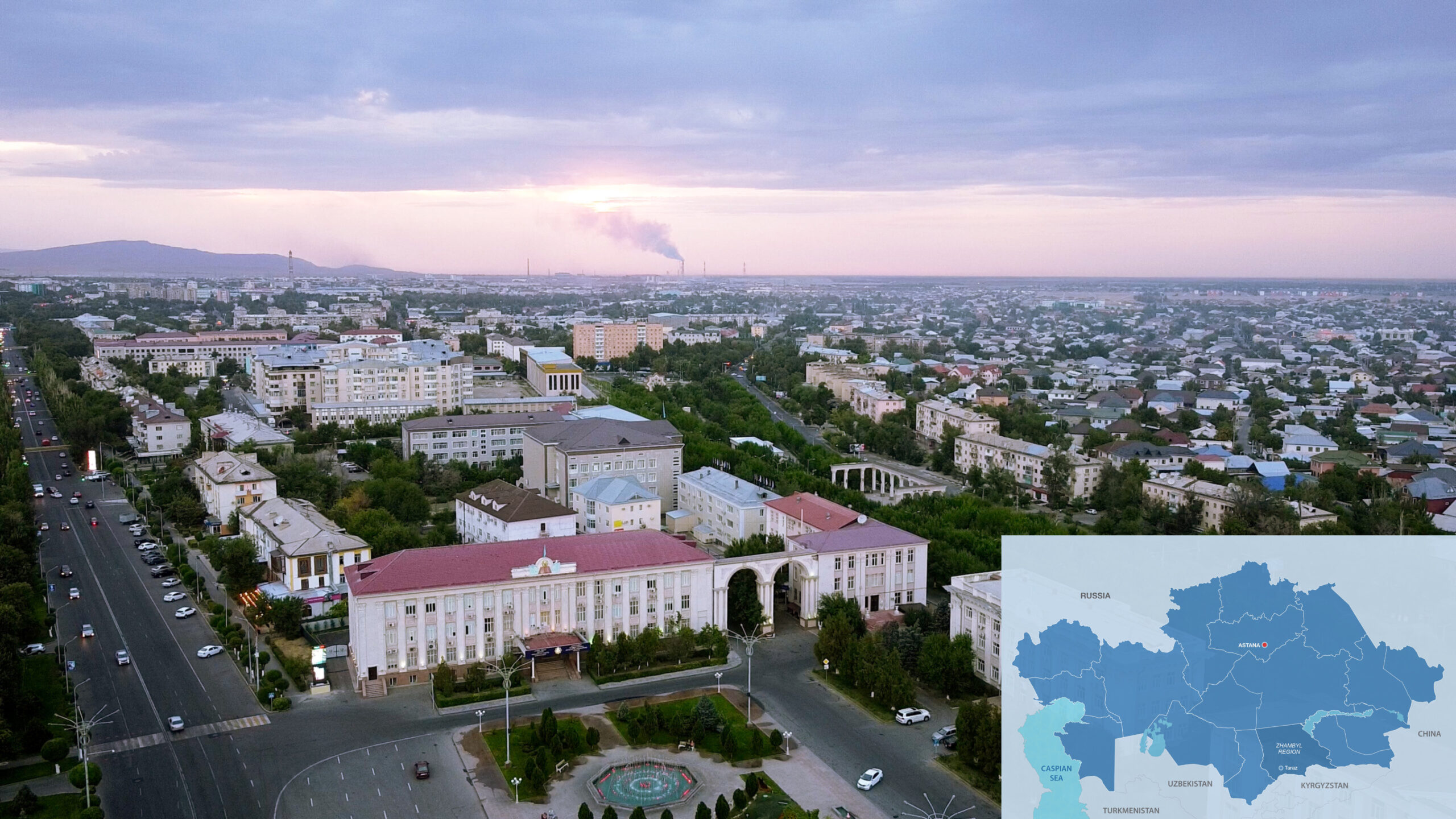Editor’s Note: The Astana Times continues its series of articles, Exploring Kazakhstan, City by City, this time focusing on Kazakhstan’s oldest city Taraz. We are setting out to unveil the rich diversity of cities to bring you closer to the heart and soul of Kazakhstan.
ASTANA – The once-mighty city of Taraz, the cradle of Islamic culture, craftsmanship and trade, besieged by wars, now holds a unique cultural and political identity. These days, the administrative center of the Zhambyl Region, located on the Talas River in the south of Kazakhstan, has inadvertently become a perfect destination for history lovers and pilgrims seeking sacred sites.
Taraz. Photo credit: ec-sport.kz Click to see the map in full size. The map is designed by The Astana Times.
2,000 year-old history
Taraz’s original history lies buried beneath over two millennia of urban evolution. The exact founding date of the city remains unknown, though it is believed to have occurred before the common era. The city was first mentioned in Greek written sources in 400 under the name Tolosa (Talas) as one of the sites of the Silk Road.
Due to its strategic location on the Silk Road, Taraz has always been an important city. It became one of the most important trade centers, an Islamic stronghold, and a crucial role in the development of a thriving artisanry tradition.
The city was first mentioned in Greek written sources in 400 under the name Tolosa (Talas) as one of the sites of the Silk Road. Photo credit: e-history.kz
The name Taraz is ultimately derived from the mispronunciation of the Talas River due to linguistic nuances of the Arab language. According to another version, Taraz came from the Kazakh word ‘tarazy,’ which means scales. It is a name that certainly reflects Taraz’s history as a trading hub.
The city reached great prosperity in the 10th and 12th centuries when the Karakhanids, a Karluk Turkic khanate that ruled Central Asia, established Taraz as their capital.
The city with a history of 2000 years was the center of the trading industry in ancient times, and for many years it continues to be a museum, where many cultural relics are concentrated. Photo credit: e-history.kz
Karakhanids were the first to embrace Islam, as evidenced by the remains of the first mosque, built in the 10th century and discovered in 2006 in Taraz. The mosque’s Arabic-style columns and west-facing mihrab (a niche in the mosque pointing to Mecca) confirm its Islamic nature. However, historians believe the site originally housed a Christian, specifically Nestorian, temple built in the sixth or seventh centuries, which was later converted into an Islamic mosque.
In the years to come, Taraz was besieged by wars while resisting the Mongol invasion. The city was burned and destroyed, as evidenced by fire traces found during the excavation of the ancient settlement.
The ancient market
To understand the ancient city, archaeologists had to peel back the modern one. In 2011, the local government relocated the central market, which had existed on this site for hundreds of years to allow archeologists to dig up the earth. The results of the archaeological work were remarkable.
The Ancient Taraz archaeological park. Photo credit: kazakhstan.travel
Within a short period of time, archaeologists have discovered around 40,000 artifacts dating from the sixth to the 12th centuries, including a medieval citadel, mosque, madrasah (Islamic educational institution), a fire worshippers’ altar, prison cell, and the foundations of residential buildings.
Excavations have also revealed an extensive network of clay water pipes, remains of architectural structures, paved streets, and numerous products crafted by skilled artisans, all testifying to the city’s former greatness.
Archaeological and research work have been carried out here for many years, shedding light on the history of the steppe civilization. Among the exhibits there are centuries-old coins, household items and dishes, as well as petroglyphs. Ruins of a mosque, madrasas and baths were also discovered here. Photo credit: kazakhstan.travel
This area, once the site of the ancient city’s market, has been transformed into the largest historical and cultural complex in Kazakhstan – the Ancient Taraz archaeological park.
Historical and cultural monuments
Taraz’s outstanding attractions are its group of ancient historical monuments and mausoleums. The city has over 3,000 monuments. Five of them are included in the United Nations Educational, Scientific and Cultural Organization (UNESCO) World Heritage List. These are Balasagun, Kulan, Ornek, Kostobe, and Akyrtas. Many were erased by violent conflicts, but tourists can still savor a few surviving gems, such as the Aisha-bibi mausoleum or the Tekturmas monument.
Aisha bibi Mausoleum. Photo credit: e-history,kz
Especially impressive is the 12th-century mausoleum of Aisha-bibi, a beautiful young woman. Legend has it that the young ruler Karakhan fell in love with her, but her father rejected his advances. Despite this, the two lovers decided to elope, but Aisha perished after being bitten by a snake during their flight. In grief, Karakhan erected a mausoleum in her honor.
Karakhan Baba Mausoleum. Photo credit: e-history.kz
Another outstanding object of the city’s history is Tekturmas, a monument from the 14th century. It is believed to be the resting place of Sultan Mahmud Khan, a local saint and the commander-in-chief of the Karakhanid troops. The monument-mausoleum was demolished in the early 20th century and reconstructed based on surviving photographs. From the Tekturmas hill, visitors are treated to a beautiful panorama of the city sprawling below.
Taraz – artisan city
As early as the seventh century, Taraz experienced a powerful handicraft boom. Alongside skilled potters and fabric manufacturers, including silk producers, the city boasted artisans proficient in jewelry making, leatherwork, woodworking, gunsmithing, stone cutting, and glassblowing.
In the words of the 10th-century geographer and traveler from Baghdad, Ibn Haukal, Taraz was described as a “place of trade between Muslims and Turks.”
Photo credit: e-history.kz
By the 19th century, records from Russian officer Moritz Lerche detailed a diverse array of imported and local goods sold at the Taraz market, “(…) stalls with copper, iron and iron products, stalls with fabrics, carpets, Russian cloths, stalls with uruk (dried apricots), raisins, nuts, tea, sugar, tobacco, earthenware of local production.”
Taraz’s pivotal role in craftsmanship development gained newfound recognition when, in 2022, it became Kazakhstan’s first city to be included on the World List of Craft Cities by the World Crafts Council.
Economic development
As the administrative center of the Zhambyl Region, Taraz is the largest city in the region and one of the largest in south Kazakhstan, with a population of over 400,000 people.
Small businesses play a crucial role in the development of the city’s economy by addressing unemployment and supplying the market with domestic goods and services. In 2021, out of more than 38,000 entrepreneurial entities, 68.6% were operating full-time, according to Ec-Sport information agency.
Large chemical complex for mineral fertilizers production in Zhambyl Region. Photo credit: primeminister.kz
The region is home to over 30 large, medium, and small enterprises engaged in food production. This sector includes the production of meat, dairy products, sugar, flour from cereals, and animal feed. The sugar industry, in particular, stands out as a leading branch within the food sector.
Taraz also hosts enterprises in the metallurgical and metal processing industries. The Imstalcon Zhambyl Metal Structures Plant, established in 1967, is a key player in manufacturing and installing steel structures in Kazakhstan and neighboring countries.
Among the light industry production facilities in Taraz are those specializing in producing washed wool, processing leather from cattle hides, and manufacturing leather footwear.
How to get to Taraz
The city is connected to the world via its international airport and train station. Domestic flights link Taraz to Astana, Almaty, and Atyrau, while international flights provide direct access to Moscow.
The series previously featured Zhezkazgan, Shymkent, Taldykorgan, Karagandy, Ust-Kamenogorsk and Kostanai.
Subscribe to Updates
Get the latest creative news from FooBar about art, design and business.


